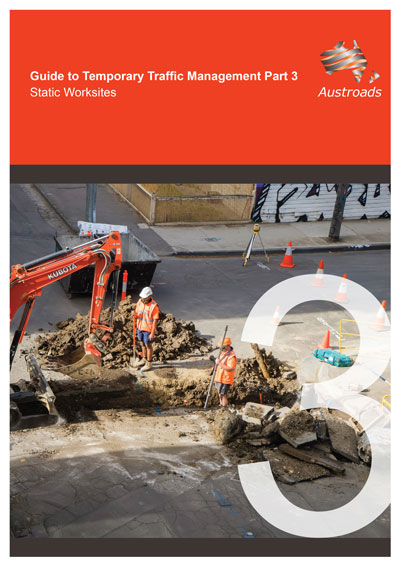Temporary Traffic Management

Guide to Temporary Traffic Management Part 3: Static Worksites
- Publication no: AGTTM03-21
- ISBN: 978-1-922382-93-1
- Published: 13 September 2021
- Edition: 1.1
- PDF (free) Download
Guide to Temporary Traffic Management Part 3: Static Worksites has been prepared to assist with the preparation of traffic guidance schemes (TGSs), in accordance with Austroads best practice. It provides general information about the context and components of designing temporary traffic guidance schemes at static worksites.
Watch the video below for an overview of Part 3.
- 1. Introduction
- 1.1 Purpose
- 1.2 Structure of AGTTM
- 1.3 Scope of Part 3
- 1.4 Application of Part 3 to New Zealand
- 1.5 Definitions
- 2. Design Process
- 2.1 General
- 2.2 Risk Assessment
- 2.2.1 Risk considerations
- 2.2.2 Hierarchy of control - eliminate, separate or control
- 2.3 Design Steps – Around, Through, Past
- 2.4 Design Balance
- 2.5 Essential Design Principles
- 2.5.1 Worksite layout
- 2.5.2 Worksite access
- 2.5.3 Signs
- 2.5.4 Sight distance
- 2.5.5 Road categories
- 2.5.6 Traffic volume
- 2.5.7 Traffic lanes
- 2.5.8 Lane width
- 2.5.9 Speed
- 2.6 Variations to Design
- 3. Around the Worksite
- 3.1 General
- 3.2 Worksite Layout
- 3.3 Separate the Work Area
- 3.4 Road Closures
- 3.4.1 Property access
- 3.5 Safe Traffic Speed
- 3.6 Safety Buffer
- 3.7 Advance Warning Area
- 3.8 Design and Traffic Management
- 3.8.1 Detours
- 3.8.2 Detours via Sidetracks
- 3.8.3 Contraflow
- 3.9 Termination Area
- 3.10 Vulnerable Road Users
- 3.10.1 Pedestrians
- 3.10.2 Cyclists
- 3.10.3 Motorcyclists
- 3.11 Public transport
- 4. Through the Worksite
- 4.1 General
- 4.2 Worksite Layout
- 4.3 Separate the Work Area
- 4.4 Delineate the Route
- 4.5 Safe Traffic Speed
- 4.6 Safety Buffer
- 4.7 Traffic Control and Site Entry
- 4.8 Advance Warning Area
- 4.9 Termination Area
- 4.10 Vulnerable Road Users
- 4.10.1 Pedestrians
- 4.10.2 Cyclists
- 4.10.3 Motorcyclists
- 4.11 Public transport
- 5. Past the Worksite
- 5.1 General
- 5.2 Worksite Layout
- 5.3 Separate the Work Area
- 5.3.1 Road safety barrier system
- 5.3.2 Containment fence
- 5.3.3 Visibility screens
- 5.4 Delineate the Route
- 5.4.1 Traffic cones and bollards
- 5.4.2 Temporary hazard markers
- 5.4.3 Temporary kerbing
- 5.4.4 Shuttle flow
- 5.5 Safe Traffic Speed
- 5.5.1 Temporary speed limits
- 5.5.2 Temporary speed humps
- 5.5.3 Rumble strips
- 5.6 Safety Buffer
- 5.7 Overhead Clearance
- 5.8 Additional Warning Area and Devices
- 5.8.1 Truck mounted attenuators
- 5.9 Transition Area
- 5.9.1 Tapers
- 5.9.2 Chicanes
- 5.9.3 Contraflow
- 5.10 Traffic Control
- 5.10.1 Portable traffic control devices
- 5.10.2 Traffic controllers
- 5.10.3 Site entry
- 5.11 Advance Warning Area
- 5.12 Termination Area
- 5.13 Vulnerable Road Users
- 5.13.1 Pedestrians
- 5.13.2 Cyclists
- 5.13.3 Motorcyclists
- 5.14 Public Transport
- 6. Design for Additional Issues
- 6.1 General
- 6.2 Permanent Traffic Signals
- 6.3 Roundabouts
- 6.4 Overtaking Lane
- 6.5 Shoulder as a Temporary Lane
- 6.6 Pavement Markings
- 6.7 Night Works
- 6.8 Excavations
- 6.9 Unattended Worksites
- 6.10 Placement and Operation of Portable Variable Message Sign (VMS)
- 6.10.1 Principles and guidance
- 6.10.2 Aiming distance
- 6.10.3 Longitudinal placement
- 6.10.4 Lateral placement
- 6.10.5 Visibility
- 7. How to Apply the Traffic Guidance System
- 7.1 General
- 7.2 Pre-installation
- 7.3 Installation
- 7.4 Removal
- 7.4.1 Redundant devices
- 7.4.2 Ghost markings
- 7.5 Inspection and Record Keeping
- References
Related publications
Latest Temporary Traffic Management News
